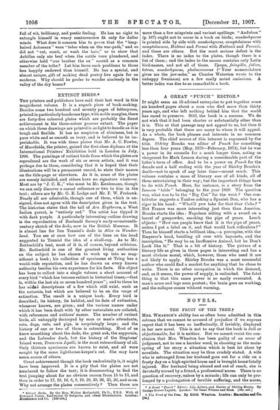EXTINCT BIRDS.*
THE printers and publishers have said their last word in this magnificent volume. It is a superb piece of book-making. Besides some two hundred and seventy pages of letterpress, printed in particularly handsome type, with noble margins, there are forty-five coloured plates which are probably the finest achievement in the three-colour process extant. The paper on which these drawings are printed is as light to handle as it is tough and flexible. It has no suspicion of shininess, but is ware white and as smooth as ivory, and is believed to be im- perishable. It was with these plates that Mr. A. C. Fowler, of Igloorfields, the printer, gained the first-class diploma at the International Printers' Exhibition held in London in July, 1906. The paintings of extinct birds from which the plates are reproduced are the work of six or seven artists, and it was perhaps due to them, considering that it is hoped that their illustrations will be a permanent record, to state their names on the title-page or elsewhere. As it is, some of the plates are merely initialled, and others have no signature whatever. Most are by "J. C. K.," who must be Mr. Keulemans, though we can only discover a casual reference or two to him in the text ; others are by Mr. G. E. Lodge and Mr. F. W. Frohawk. Nearly all are admirable, though. one of them, which is un- signed, does not agree with the description given in the text. The historian states that the tail of Ara Erythrura, a West Indian parrot, is "entirely red." The artist has tipped it with dark purple. A particularly interesting outline drawing is the reproduction of Roelandt Savery's early-seventeenth- century sketch of the dodo, now in the British Museum. It is almost line for line Tenniel's dodo in Alice in Wonder- land. You see at once how one of the lines on the head suggested to Tenniel the idea of a skull-cup. As to Mr. Rothschild's text, most of it is, of course, beyond criticism. Mr. Rothschild is one of the greatest living authorities on the subject he has chosen to work up into so mag- nificent a book ; his collection of specimens at Tring has a world-wide reputation, and he has drawn on every known authority besides his own experience for his facts. His object has been to collect into a single volume a short account of every bird "which has become extinct in historical times,—that is, within the last six or seven hundred years"; and to these he has added descriptions of a few which still exist, such as the notornis, but which are believed to be on the verge of extinction. The result is a unique book. Every bird is described ; its history, its habitat, and its date of extinction, -whenever known, are given ; and the various names under which it has been dealt with by other naturalists are collated, with references and authors' names. The number of extinct birds, all unhappily destroyed by man or man's attendants, cats, dogs, rats, and pigs, is surprisingly large; and the history of one or two of them is astonishing. Most of us know something about the dodo, the great auk, the aepyornis, and the Labrador duck, but the history of the Stephens' Island wren, Traversia Lyalli, is the most extraordinary of all. Only thirteen specimens are known to exist, and all were caught by the same lighthouse-keeper's cat. She may have eaten scores of others.
Great achievement though the book undoubtedly is, it might have been improved. It is a pity that the plates are not numbered to follow the text; it is disconcerting to find the text jumping about for no obvious reason from 15 to 13, and then in order to 17, 18, 16, 8, 9, 19, 20, 39, 36, 35, 26, and soon. Why not arrange the plates consecutively ? Then there are
• Extinct Birds. By the Hon. Walter Rothschild, Ph.D., F.Z.S. With 45 Coloured Plates, Embracing 63 Subjects, and other Illustrations. London: Hutchinson and Co. [525 net.] more than a few misprints and variant spellings. "Audubon" (p. 167) ought not to occur in a book on birds; anadorhyncus is printed side by side with anodorhyncus, caniptolaimus with camptolaemus, Huttoni and Tema with Sultonii and Peronii, and there are others. But the most serious defect is the index. There is no index to the plates, though there is a list of them ; and the index to the names contains only Latin bird-names, and not all of those. Upupa, fringilla, fulica, tetrao, anadorhyncus, phalacrocoraz (" Your nomenclature gives me the jaw-ache," as Charles Waterton wrote to the unhappy Swainson) are a few easily noted omissions. A. better index was due to so remarkable a book.














































 Previous page
Previous page